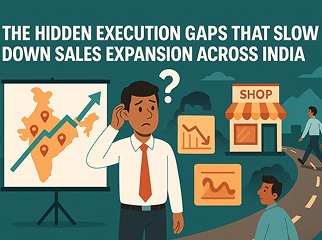

The Hidden Execution Gaps That Slow Down Sales Expansion Across India
Expanding sales across India always looks impressive on a PowerPoint slide. The glossy maps, optimistic heat zones, and upward-sloping charts promise scale. But once a strategy crosses the boardroom threshold and enters the bazaar, the terrain reshapes itself completely. It becomes layered, erratic, and deeply humbling.
India is not a single market — it is an intricate constellation of micro-markets, each with its own retail cadence, cultural nuance, and competitive undercurrent. A distribution strategy that thrives in Jaipur may hit a wall in Coimbatore. A salesperson who excels in Lucknow may find Surat’s commercial pulse unfamiliar. And a B2C GTM model built for metro sophistication rarely translates seamlessly into Tier-2 and Tier-3 markets.
Yet, when brands decode these nuances — especially in categories like FMCG sales India, consumer electronics India, fast-moving consumer durables India, and broader consumer goods India — the growth curve accelerates in astonishing ways.

A Field Story: When Expansion Metrics Hide the Real Problem
A consumer-goods brand approached us after undertaking a seemingly robust scale-up. They had expanded into 30 new towns, activated 180 new retailers, and appointed a seasoned sales lead for the North Zone.- The dashboards were glowing green.
- Coverage numbers strong. Distribution footprint expanding. Geography unlocked.
- Yet revenue refused to budge.
Different teams pointed fingers in different directions:
– The founder suspected a product flaw.
– Leadership blamed pricing elasticity.
– The sales team dismissed it as “slow market sentiment.”
– The truth required stepping into the field.
What the Ground Reality Uncovered
Across twelve towns, we shadowed frontline executives, assessed visibility, engaged retailers, and audited beat plans. The findings revealed what spreadsheets rarely capture — the hidden execution gaps:
- 42% of new outlets hadn’t placed a second order →
A classic sign of distribution gaps and weak retail pull. - Beat coverage accuracy sat at just 63% →
A major field execution issue affecting market discipline. - Retailers had inventory but no activation or advocacy →
Zero product recall, minimal push, and no structured pitch flow. - Incentives rewarded coverage, not sell-through →
Directly feeding sales productivity challenges.

– Nothing was wrong with the product.
– Everything was wrong with the GTM structure.
– The real problem wasn’t expansion — it was GTM inefficiencies, missing sell-through engines, and weak capability in last-mile execution. These were the very barriers limiting consumer-goods growth across regions.

What the Ground Reality Uncovered
Across twelve towns, we shadowed frontline executives, assessed visibility, engaged retailers, and audited beat plans. The findings revealed what spreadsheets rarely capture — the hidden execution gaps:
- 42% of new outlets hadn’t placed a second order →
A classic sign of distribution gaps and weak retail pull. - Beat coverage accuracy sat at just 63% →
A major field execution issue affecting market discipline. - Retailers had inventory but no activation or advocacy →
Zero product recall, minimal push, and no structured pitch flow. - Incentives rewarded coverage, not sell-through →
Directly feeding sales productivity challenges.
– Nothing was wrong with the product.
– Everything was wrong with the GTM structure.
– The real problem wasn’t expansion — it was GTM inefficiencies, missing sell-through engines, and weak capability in last-mile execution. These were the very barriers limiting consumer-goods growth across regions.

Re-engineering the Sales Engine
To correct the trajectory, we partnered with the founder and the sales lead to recalibrate the architecture:
- Shifted KPIs from coverage to productivity
Productivity became the primary health metric. - Introduced weekly sell-through trackers
Keeping a pulse on retail velocity, not just placement. - Redesigned retailer pitch flows
More consultative, more value-led, far more effective. - Linked incentives to repeat orders
Encouraging sustained movement, not superficial expansion. - Strengthened beat discipline
structured routes, visibility norms, and non-negotiable routines.
Within a quarter, momentum replaced stagnation.
– No new product.
– No new distributor.
– No new geography.
– Just better execution governance and sharper field behaviour.
The Larger Reality for Any Brand Scaling Across India
Growth in India isn’t constrained by geography. It’s constrained by execution muscle.
The companies that scale sustainably across consumer goods, FMCG, FMCD, and consumer electronics categories are those that:
- Respect the diversity and complexity of India’s markets
- Prioritise sales fundamentals over superficial expansion
- Build systems that drive field discipline
- Invest in continuous capability building
- Treat execution as a strategic asset, not an operational afterthought

– A solid strategy collapses when execution is fragile.
– Even a modest strategy thrives when execution is precise.
– Scaling across India is never linear. Every region, cluster, and retailer tells a different story.

The Larger Reality for Any Brand Scaling Across India
Growth in India isn’t constrained by geography. It’s constrained by execution muscle. The companies that scale sustainably across consumer goods, FMCG, FMCD, and consumer electronics categories are those that:- Respect the diversity and complexity of India’s markets
- Prioritise sales fundamentals over superficial expansion
- Build systems that drive field discipline
- Invest in continuous capability building
- Treat execution as a strategic asset, not an operational afterthought
– A solid strategy collapses when execution is fragile.
– Even a modest strategy thrives when execution is precise.
– Scaling across India is never linear. Every region, cluster, and retailer tells a different story.
What has your experience been while expanding sales across markets?
Share your insights — the ecosystem grows stronger when real stories surface.
